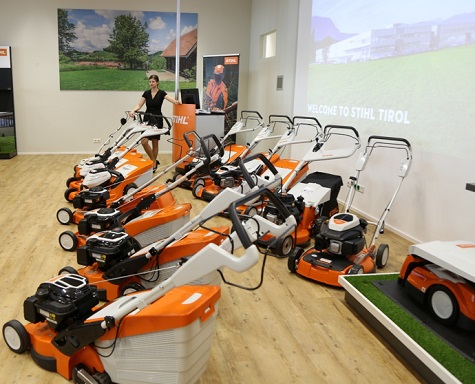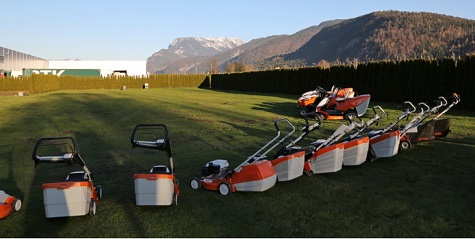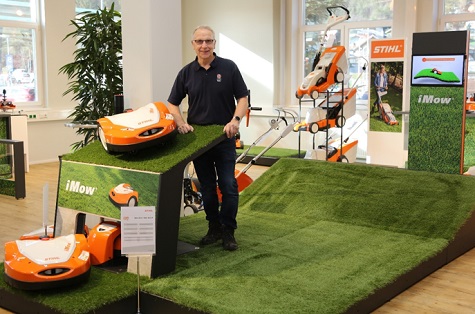Last week I was privileged to have been invited to attend, along with my work colleague Steve Gibbs, editor of Service Dealer, a STIHL press trip to one of their manufacturing facilities in Tirol, Austria.
This factory site was formerly the production line for the Viking brand of garden shredders in 1982, before progressing on to making Viking lawn mowers in 1984.
In 1992 STIHL bought out Viking and began the renewal of the range of garden tools they could offer. The company were still producing a range of mowers and selling them under the brand name of Viking. However, in 2017 the process of amalgamation began and by 2019 all products are now being sold with STIHL orange branding.

Viking museum at Tirol
This long-time partnership and acquisition has allowed the STIHL brand to further its strength in both the professional and domestic markets selling a whole new range of garden machinery from small hand tools through to pedestrian and ride on mowers - with an emphasis on cordless and battery powered products.

A substantial investment has been made to develop the site over the years, with the most recent construction phase IV being completed in 2019 with a usable floor space of 20,000 m² (the largest extension of STIHL Tirol to date) virtually doubling the size of the factory site.
A family-owned business based in Germany, STIHL employs more than 17,000 staff worldwide and sells products in more than 160 countries globally. The company’s range spans chainsaws, hedge and grass trimmers, multi-tools, pressure washers, construction tools, lawn mowers, lawn tractors, robotic mowers and other garden equipment.

STIHL GB is a wholly-owned subsidiary of the global STIHL Group. In Great Britain, the company's products are available from more than 700 specialist Approved Dealers who offer expert customer service.
There were over thirty members of the press attending this event. Myself, Steve and a number of other turf professional trade magazines were joined by a large contingent of mainstream gardening press. Journalists who write the gardening columns for national newspapers, magazines and blogs.
It was nice to find out some of their thoughts on our industry and where they saw our industry going in the next few years, particularly on the robotic mower front. They also had the same concerns as me, in how do we encourage the next generation of gardeners and groundsmen to come and work in our industry.

We were met by a delegation of STIHL employees, led by Bernadette Karner Koessl, PR and marketing manager, who welcomed us all to the factory. The day’s visit saw us witness the complete manufacturing process and assembly line of a wide range of STIHL cordless battery products.

At Tirol we were shown, and were able to test, some new handheld machinery, some of which haven't been officially announced yet, including new domestic and professional mowers. Also, we heard of some interesting control developments for the iMows.

The new smart integration for the robots means the autonomous units can now be issued commands via smart watches integrated with the iMow app; via Amazon Alexa; and via innogy SmartHome, which is an advanced home control system being integrated into some new-build housing. STIHL also said how they were in negotiations with other smart control providers like Google Assistant to establish contracts with those guys as well.
There is no doubt that the popularity of these new smart robotic mowers will increase in the UK market in the coming years. Local machinery dealers are already seeing a large increase in sales year upon year.

With the rapid advancement in GPS tracking technologies I am also sure it will not be long before we can map out our mowing areas via use of a smart phone and send the relevant information to these intelligent mowers thus improving the performance and productivity of these machines.
I was also impressed with their STIHL Connected system that gives professional users a detailed overview of key power tool data via a portal in order to enhance maintenance programmes and fleet management efficiencies.

STIHL Connected comprises three central system components; STIHL Smart Connector, STIHL app, and STIHL connect pro portal. When used in conjunction, the system enables professional users to analyse key machinery performance data that can be used to ‘improve daily work processes’, and also help achieve optimum task scheduling.
The pro portal enables the digital management of an entire machinery fleet, meaning users can add or remove power tools, schedule work and view pending maintenance appointments. Users can also see the last position of an active power tool, giving them complete visibility of the whereabouts of any tool, as long as location services on the connected phone are enabled
Developments like this all could have the potential to appeal to tech savvy youngsters, who might be interested in working in a sector where it will be commonplace for them to deal with the latest gadgets.

STIHL told the press they are very much still a premium brand, albeit one with an eye on both ends of the market, with battery products for both entry-level domestic consumers and high-end professional users.
With companies such as these in the industry, investing heavily in new product development and, crucially, in marketing these the products to the public to increase awareness of what's going on in our sector, it would be great to think we can enter the new decade with a positive outlook.
I would like to take this opportunity to thank everybody at STIHL for their kind generosity and hospitality and wish them a happy Christmas and prosperous New Year.
There’s no doubt, we will be seeing a lot more intriguing new cordless products coming to market in the next few years for both the professional and domestic markets.